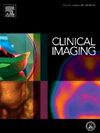Predicting lymph node metastasis in thyroid cancer: systematic review and meta-analysis on the CT/MRI-based radiomics and deep learning models
IF 1.8
4区 医学
Q3 RADIOLOGY, NUCLEAR MEDICINE & MEDICAL IMAGING
引用次数: 0
Abstract
Background
Thyroid cancer, a common endocrine malignancy, has seen increasing incidence, making lymph node metastasis (LNM) a critical factor for recurrence and survival. Radiomics and deep learning (DL) advancements offer the potential for improved LNM prediction using CT and MRI, though challenges in diagnostic accuracy remain.
Methods
A systematic review and meta-analysis were conducted per established guidelines, with searches across PubMed, Scopus, Web of Science, and Embase up to February 15, 2024. Studies developing CT/MRI-based radiomics and/or DL models for preoperative LNM assessment in thyroid cancer patients were included. Data were extracted and analyzed using R software.
Results
Sixteen studies were analyzed. In internal validation sets, sensitivity was 81.1 % (95 % CI: 75.6 %–85.6 %) and specificity 76.4 % (95 % CI: 68.4 %–82.9 %). Training sets showed a sensitivity of 84.4 % (95 % CI: 81.5 %–87 %) and a specificity of 84.7 % (95 % CI: 74.4 %–91.4 %). The pooled AUC was 86 % for internal validation and 87 % for training. Handcrafted radiomics had a sensitivity of 79.4 % and specificity of 69.2 %, while DL models showed 80.8 % sensitivity and 78.7 % specificity. Subgroup analysis revealed that models for papillary thyroid cancer (PTC) had a pooled specificity of 76.3 %, while those including other or unspecified cancers showed 68.3 % specificity. Despite heterogeneity, significant differences (p = 0.037) were noted between models with and without clinical data.
Conclusion
Radiomics and DL models show promising potential for detecting LNM in thyroid cancer, particularly in PTC. However, study heterogeneity underscores the need for further research to optimize these imaging tools.
预测甲状腺癌淋巴结转移:基于CT/ mri放射组学和深度学习模型的系统回顾和荟萃分析。
背景:甲状腺癌是一种常见的内分泌恶性肿瘤,其发病率越来越高,淋巴结转移(LNM)是影响其复发和生存的关键因素。放射组学和深度学习(DL)的进步为利用CT和MRI改进LNM预测提供了潜力,尽管在诊断准确性方面仍然存在挑战。方法:根据既定指南进行系统评价和荟萃分析,检索PubMed, Scopus, Web of Science和Embase,截止到2024年2月15日。研究开发基于CT/ mri的放射组学和/或DL模型,用于甲状腺癌患者术前LNM评估。使用R软件对数据进行提取和分析。结果:共分析了16项研究。在内部验证集中,灵敏度为81.1% (95% CI: 75.6% - 85.6%),特异性为76.4% (95% CI: 68.4% - 82.9%)。训练集的灵敏度为84.4% (95% CI: 81.5% - 87%),特异性为84.7% (95% CI: 74.4% - 91.4%)。内部验证的合并AUC为86%,培训的合并AUC为87%。手工放射组学的敏感性为79.4%,特异性为69.2%,而DL模型的敏感性为80.8%,特异性为78.7%。亚组分析显示,甲状腺乳头状癌(PTC)模型的总特异性为76.3%,而包括其他或未明确癌症的模型的特异性为68.3%。尽管存在异质性,但在有无临床资料的模型之间存在显著差异(p = 0.037)。结论:放射组学和DL模型在甲状腺癌,特别是PTC的LNM检测中具有良好的应用前景。然而,研究的异质性强调了进一步研究以优化这些成像工具的必要性。
本文章由计算机程序翻译,如有差异,请以英文原文为准。
求助全文
约1分钟内获得全文
求助全文
来源期刊

Clinical Imaging
医学-核医学
CiteScore
4.60
自引率
0.00%
发文量
265
审稿时长
35 days
期刊介绍:
The mission of Clinical Imaging is to publish, in a timely manner, the very best radiology research from the United States and around the world with special attention to the impact of medical imaging on patient care. The journal''s publications cover all imaging modalities, radiology issues related to patients, policy and practice improvements, and clinically-oriented imaging physics and informatics. The journal is a valuable resource for practicing radiologists, radiologists-in-training and other clinicians with an interest in imaging. Papers are carefully peer-reviewed and selected by our experienced subject editors who are leading experts spanning the range of imaging sub-specialties, which include:
-Body Imaging-
Breast Imaging-
Cardiothoracic Imaging-
Imaging Physics and Informatics-
Molecular Imaging and Nuclear Medicine-
Musculoskeletal and Emergency Imaging-
Neuroradiology-
Practice, Policy & Education-
Pediatric Imaging-
Vascular and Interventional Radiology
 求助内容:
求助内容: 应助结果提醒方式:
应助结果提醒方式:


